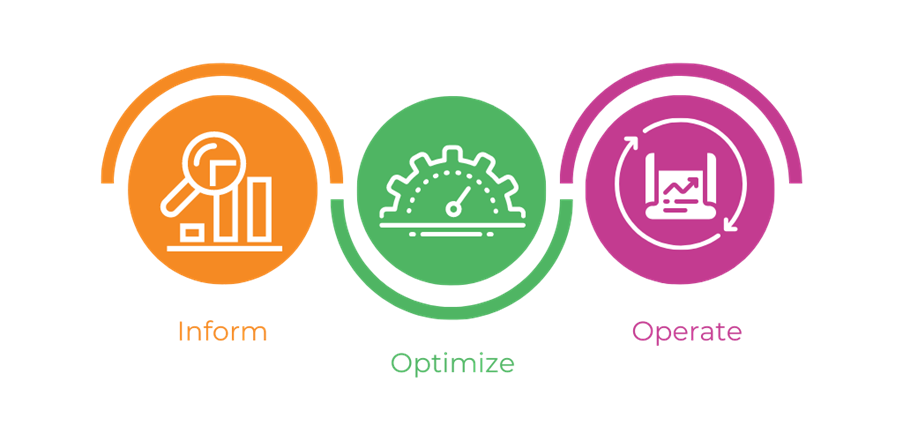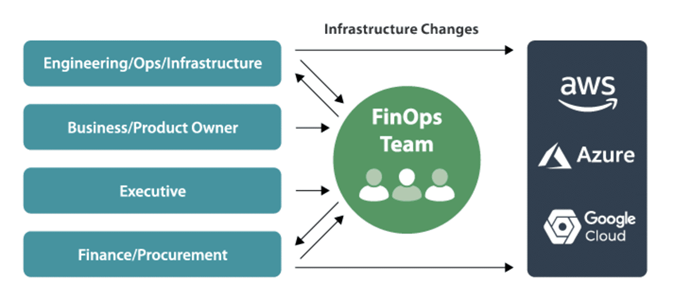What is FinOps?
FinOps (a portmanteau of “Finance” and “DevOps”) is a cultural practice for cloud financial management. It brings engineering, finance, and business teams together to gain visibility and control over cloud spending. According to the FinOps Foundation, FinOps “maximizes the business value of cloud” by enabling data-driven decisions and creating financial accountability.
In practice, FinOps is not just about cutting costs, it’s about ensuring every dollar spent in the cloud drives strategic value. In other words, FinOps empowers teams to make informed trade-offs between speed, cost, and quality when designing and operating cloud systems.

Why FinOps Matters for Cloud Users
Cloud services use a pay-as-you-go, variable-cost model that can be hard to predict or allocate. Traditional budgeting methods often fail in this dynamic environment. A common challenge is that finance teams don’t know where the cloud budget is spent, and engineering teams don’t see the cost impact of their work. FinOps addresses this by promoting cross-team visibility and accountability, including key benefits like:
- Transparency: FinOps ensures all stakeholders see up-to-date cost data. Cloud resources are tagged and monitored so developers understand how features translate to spend, and finance sees how changes in usage drive costs.
- Cost Optimization: By continuously monitoring usage and rightsizing resources, teams identify waste and apply savings (e.g. Reserved Instances, Savings Plans). AWS tools like Cost Explorer and Compute Optimizer help automate these optimizations.
- Business Alignment: Rather than just slashing budgets, FinOps shifts focus to value per cost. For example, teams can track unit costs (cost per transaction, per user, etc.) to see how efficiently cloud spend supports growth.
- Predictability and Control: A FinOps practice improves forecasting and budgeting. By enforcing tagging and using unified reporting, organizations move from reacting to cost spikes to planning for them. AWS now offers detailed billing export and improved Cost Explorer analytics to support this predictability.
Core FinOps Practices
FinOps involves processes and principles to sustain cost discipline. Some key practices include:
- Form a FinOps Team: Establish a cross-functional cost center or FinOps committee (including finance managers, engineering leads and product owners) to set cloud cost policies and KPIs. This team acts as a “governing body” that defines budgets, monitors performance, and aligns spending with business goals.
- Increase Cost Visibility: Make cloud costs transparent across the organization. Provide role-based dashboards or reports so each group sees only the data they need (e.g. engineers see resource-level spend; finance sees overall trends). Consistent tagging and cost allocation (by project, team or feature) is critical here.
- Centralize Cost Data: Create a single source of truth for cloud costs, like a unified cost dashboard or data warehouse. This avoids “multiple dashboards” confusion and ensures everyone works based on the same numbers.
- Optimize Usage Continuously: Use a mix of automated tools and review processes to cut waste. For example, apply AWS Savings Plans or Reserved Instances where appropriate, but avoid oversized commitments. FinOps teams sweep for idle resources (e.g. old snapshots or underused VMs) and rightsizing opportunities. In one case, simply deleting forgotten storage buckets saved thousands per year. Over time, engineers may also refactor workloads to use more efficient cloud-native services.
- Align Costs with Value: Move beyond raw spend to value metrics. Measure “cost per customer” or “cost per feature” instead of just total dollars. This way, teams see the ROI of their cloud investments. When a new feature driving revenue raises costs, FinOps shows that it was a net gain rather than “waste”.

AWS Cloud Financial Management
As an AWS Partner, it’s useful to empower AWS’s built-in FinOps support. AWS offers a suite of cloud cost management tools and resources to provide the best experience:
- Cost Tools: Services like AWS Cost Explorer, AWS Budgets, AWS Cost Anomaly Detection, and AWS Compute Optimizer provide out-of-the-box ways to analyze and control spendings.
- Billing Data: AWS supports the FinOps Open Cost and Usage Standard (FOCUS 1.0). As of late 2024, AWS lets you export billing data in FOCUS format for multi-account reporting. This open schema (created by the FinOps Foundation) makes it easier to combine AWS costs with other sources.
Overall, AWS treats FinOps as a first-class discipline. Its blogs and case studies emphasize empowering engineers with cost data. Where AWS partners and solution providers often help customers set up FinOps programs: one APN blog notes that without FinOps, engineering modernization and finance constraints often collide, stalling cloud projects.
FinOps and DevOps: Complementary Approaches
DevOps and FinOps share a common goal of efficient, high-quality delivery. DevOps (automation, CI/CD, rapid iteration) focuses on speed and reliability. FinOps adds the dimension of cost-awareness to that process. Rather than being in conflict, the two disciplines reinforce each other. For example:
- Culture of Collaboration: Both DevOps and FinOps break down silos. Just as DevOps teams own deployments end-to-end, FinOps encourages engineers to “own” the cost of their resources. Successful teams create a feedback loop: developers see cost implications of code changes, and finance understands deployment needs.
- Automation: DevOps relies on Infrastructure-as-Code (IaC) and pipelines; FinOps leverages the same automation. Automated tagging, cost alerts in CI/CD, and scripts to apply savings plans turn cost management into part of the build process. This way, compliance and optimization happen before releasing to production.
- Continuous Optimization: DevOps’s principle of continuous improvement matches FinOps iterative approach. After each sprint or release, teams can review actual costs versus budget, adjust resource sizes or caching strategies, and push improvements. As one expert noted, making FinOps part of DevOps workflows aligns cloud spending with goals and automates savings. Over time, the team’s “definition of done” includes not only passing tests but also meeting cost targets.
In essence, FinOps is DevOps for cloud economics. It makes cost management an integrated responsibility, not an afterthought. By treating cloud expense metrics like any other operational metric, teams can deliver faster and keep budgets in check.
Conclusion
FinOps is an essential discipline for any organization using the cloud. It complements DevOps by making cost a first-class consideration in the development lifecycle, without sacrificing agility. By adopting FinOps best practices cross-team visibility, a centralized cost framework, and continuous optimization.
Businesses unlock better ROI from their cloud investments. AWS provides many tools and programs to support FinOps, and as an AWS partner, we leverage these to help clients to gain more financial control.
Ultimately, FinOps turns cloud budgets into strategic assets. When finance, engineering and product teams collaborate on cost decisions, cloud spending becomes predictable and aligned with business value. This approach ensures that every cloud dollar accelerates innovation and growth.



